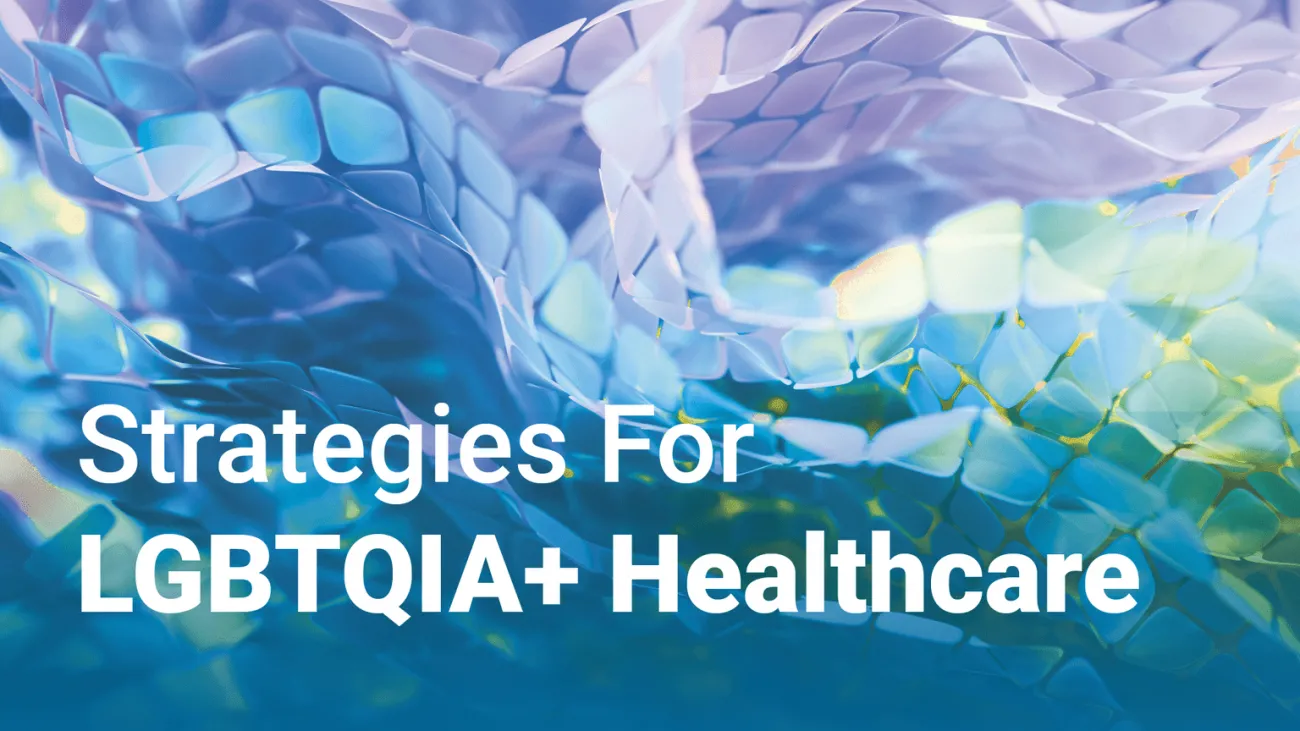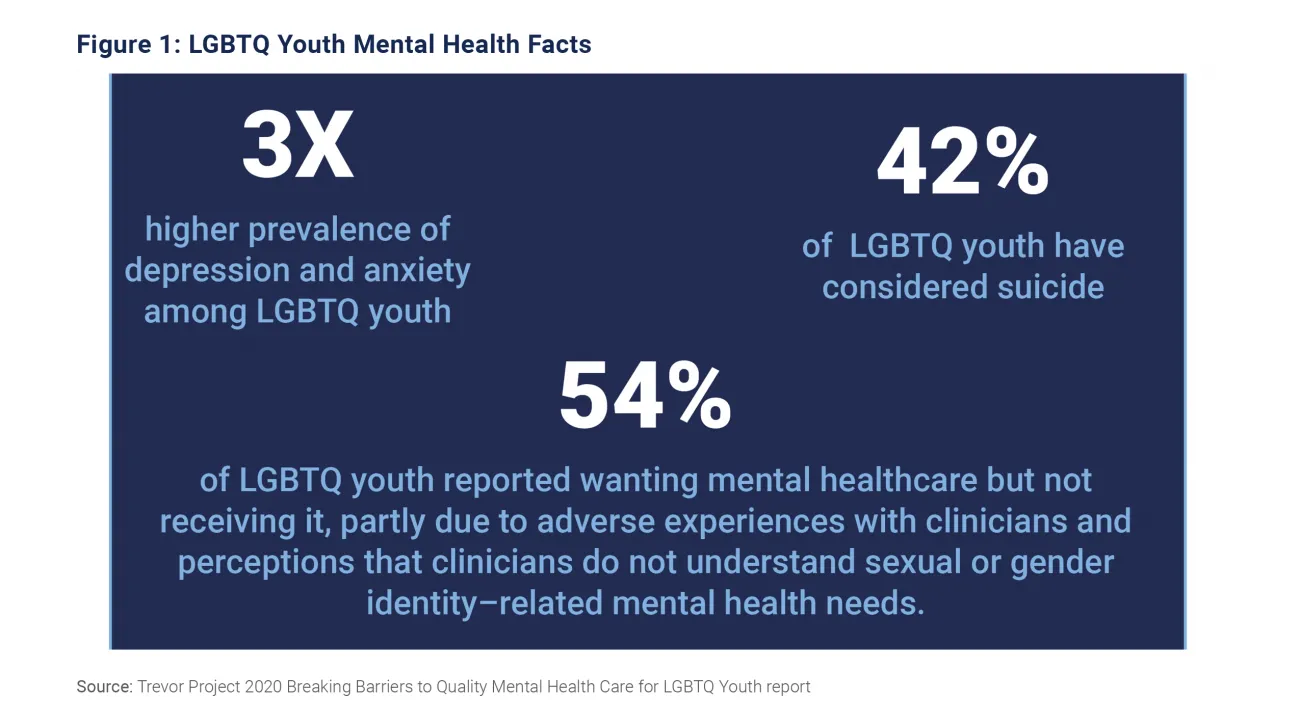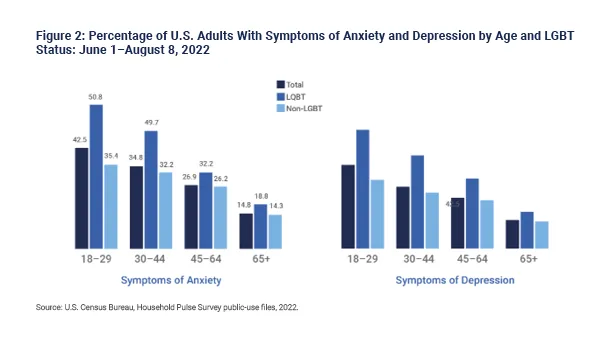We've joined our RTI Health Solutions colleagues under the RTI Health Solutions brand to offer an expanded set of research and consulting services.
For the purpose of this article, we will use LGBTQ+, or simply ‘queer’ when referring to this population, acknowledging that different sources use different language.

More than 7% of US adults identify as lesbian, gay, bisexual, or transgender (LGBT) and nearly 10% of youth ages 13-17 identify as LGBT or gender nonconforming. As this growing population has significant impact on society and culture, many individuals face numerous challenges to acceptance including: bigotry, harassment, discrimination, and anti-LBGTQ+ laws. Across the country, LGBTQ+ hotspots and queer-friendly communities have been the targets of attacks, both physical and legislative. These emotional stressors and sometimes physically violent acts can have significant effect on the well-being of LGBTQ+ people.
Challenges LGBTQ+ communities face
A 2017 study by the Williams Institute found that LGBTQ+ people are 9 times more likely than their non-LGBT counterparts to be victims of violent hate crimes, with vulnerable youth bearing a significant burden. Recognizing the volatility of the situation, in June 2023, the Human Rights Campaign declared a national state of emergency for queer people in the US, citing numerous anti-LGBTQ+ legislative moves and multiple attempts to block gender-affirming healthcare for transgender youth. To date, the Human Rights Campaign identified over 500 anti-LGBTQ+ bills introduced in state houses across the US, with 125 focused on trans youth.
Since 2013, the percentage of queer adults with healthcare access increased from 64% to 75% and partnered LGBTQ+ adults have seen upticks in insurance coverage. Despite these gains, many care gaps still remain.
"Even if you have health insurance or you're covered, if you feel that you'll encounter discrimination, people are reluctant to seek care."
Gaps in healthcare
Comprehensive discussion about health equity must include LGBTQ+ populations. Providers and patients have noted that concerns about discrimination and mistreatment have led LGBTQ+ people to delay or forego care, including nearly a quarter of transgender people who did not seek care. Delay of care can have significant medical consequences, especially because many of the conditions that disproportionally impact queer communities need time-sensitive attention, including:
- STIs/HIV
- Injuries from violent encounters
- Substance use disorder
- Mental health
- Breast and cervical cancer
- Heart disease
- Obesity and eating disorders
When individuals lack confidence that their needs will be heard and met by local healthcare providers, their overall well-being suffers. It's important for healthcare providers to be knowledgeable and make a conscious effort to create inclusive spaces that help queer community members feel safe.
Gaps in mental healthcare
Among the many gaps in care that LGBTQ+ individuals face is the availability of mental health services, particularly for youth. Queer youth face striking mental health challenges and are subject to extensive bullying and harassment in schools. Many are also abandoned by their families, which leads to homelessness. See Figure 1.

Figure 1: LGBTQ Youth Mental Health Facts
These numbers remain consistent for adults who identify as LGBT as well. See Figure 2.

Figure 2: Percentage of US adults with symptoms of anxiety and depression
Opportunities for providers
Considering these health disparities, there are many ways providers can address these concerns. LGBTQ+ healthcare fits naturally within the larger discussion of health equity and many of the strategies used for historically marginalized racial and ethnic groups work for LGBTQ+ communities as well.
Culturally competent care for queer patients includes:
- Becoming familiar with key LGBTQ+ terminology
- Inquiring about an individual's pronouns and sexual orientation on intake forms
- Screening for conditions that often impact queer people, such as anxiety, depressions, stress, eating disorders, STI, substance use disorders, and housing insecurity
- Screening for violence by asking about assault and abuse
- Training staff on LGBTQ+ issues
- Openly recognizing queer observances such as Pride, World AIDS Day, Trans Day of Remembrance, etc.
- Using gender-inclusive language on signage, paperwork, advertising, etc.
LGBTQ+ patients in rural towns endure greater difficulty in obtaining specialized care. A family practice physician in Iowa opened an LGBTQ clinic in early 2018 that operates 2 days out of the month and has made strides in caring for patients who were previously overlooked.
“From the minute I walked in the door I felt valued," said Albie Nicol, a young transgender patient. “A nurse came out and said 'Hi,' and she mentioned her pronouns and [said], 'I was wondering what pronouns I can use to refer to you.' It was so shocking to me. I felt safe, I felt important, and I felt like I was a person rather than just another patient."
The National LGBT Health Education Center offers extensive guidance for addressing queer patients with empathy and respect in their Providing Inclusive Services And Care For LGBT People guide for healthcare staff. In addition, the NIH Office of Equity, Diversity, and Inclusion has compiled an online guide of information and tips for treating and referring LGBTQ+ patients.
Digital health offers LGBTQ+-inclusive solutions
Nestled within the burgeoning field of digital health is a niche but growing subspace known as QueerTech—inclusive technology designed to support the needs of LGBTQ+ individuals. Queer technology calls on developers to design with the queer community in mind, by offering gender-inclusive pronoun options during registration and explicitly including queer people in messaging.
“Terms such as 'we provide an inclusive service' are vague and can be interpreted in different ways when promoting your solution to patients. LGBTQ+ individuals are often familiar with services and communities who claim to be supportive but have let them down, and these mixed messages have stuck with us. Please, be explicit because it really does help," writes Brett Hatfield of NHS DigitalHealth London.
The LGBTQ+ population adopts telemedicine at a higher rate than their peers. Digital health designers may find it beneficial to consider 4 key market strategies for LGBTQ+ healthcare:
- Extended Services for LGBTQ+ consumers–this is popular among mental health and fertility apps.
- Expanded health benefits for LGBTQ+ care–organizations like Stork Club offer health and family benefits to queer families and guidance on fertility and family planning.
- Queer-competent care navigation–listing providers who are trained in and eager to support queer individuals makes it readily easy for LGBTQ+ patients to find providers that match their needs.
- Virtual care clinics for LGBTQ+ needs–virtual queer clinics offer many of the same services as comprehensive clinics for anyone with a stable internet connection, regardless of housing status, age, economics, transportation, or residence.
Folx Health is a prominent company using these approaches. In 2021, it secured $25 million in funding to expand virtual care to the LGBTQ+ community and is now the largest network of LGBTQ+ specialized clinicians nationwide.
RTI Health Advance helps providers craft more inclusive care
From transgender youth looking for gender-affirming healthcare, to queer young adults with a mental illness and LGBTQ+ families searching for fertility treatment, there are many ways healthcare providers can meet the needs of LGBTQ+ communities. Contact our team of experts, who are experienced in health equity and population health strategies, to help your team offer safe, inclusive, and effective healthcare for all.
Subscribe Now
Stay up-to-date on our latest thinking. Subscribe to receive blog updates via email.
By submitting this form, I consent to use of my personal information in accordance with the Privacy Policy.